Cornwall is home to Britain’s favourite coastline.
Clear blue waters, golden beaches and dramatic cliff faces are the backdrops for quaint villages, crumbling ruins and world-class gardens. There’s so much to see in this corner of the UK; and Cornwall’s natural beauty is so consistent that it is perfect to explore via road trip.
A 3-day road trip through Cornwall doesn’t give you heaps of time – but this itinerary will help you make the most of it.
Disclaimer: Hi! this post may contain affiliate links which will take you to online retailers that sell products and services. If you click on one and buy something, I may earn a commission, see my Affiliate Disclosure for more details.
Day 1
Begin your road trip through Cornwall by exploring the south coast.
Polperro

Start your road trip in the idyllic fishing village of Polperro. This postcard-perfect community can be found high up on the south coast of Cornwall; it’s perfectly located for the beginning of your holiday in the southwest.
Cornwall is famous for its quaint seaside towns and villages – you have to visit at least one, and you may as well start with one of the best. Polperro is a charming collection of haphazardly placed cottages nestled within a ravine. The village and harbour are just wonderfully picturesque. Gently bobbing boats, 14th-century inns and the typically rugged Cornish scenery make for a stunning setting.
The narrow streets of Polperro are lined with whitewashed cottages that carry a timeless appeal. Many of these buildings are now used to host art galleries, bakeries, jewellers and a whole host of other tourist-friendly retailers. But it all has a very quaint, historic feel; as there are no cars within the village itself – you park just outside – you can enjoy a completely old-world experience in Polperro.
The Eden Project

Drive 37 minutes down the coast to arrive at one of the most iconic attractions in all of Cornwall.
The Eden Project has fascinated visitors and captured imaginations for almost two decades. Though it is a relatively new addition to Cornwall’s tourist repertoire, it is arguably the most famous.
The project began in the late 90s, with the aim that visitors would leave the site a little more in tune with the natural world. Its purpose is largely to educate the general public, but the charity is also active in conservation.
Each of the two main biomes is its own little contained world. Stepping inside one is a beautifully unique experience – it’s like being transported halfway across the globe.
The Mediterranean biome is pleasantly warm, with all the trimmings of a vineyard in Tuscany, the gnarled olive trees of a Greek island, and the fiery chillies of a Spanish valley. You can travel a little further afield just by taking a few extra steps within the biome; the vibrant South African, West Australian and Californian gardens add an even more global feel to an already worldly experience.
As wonderful as the Mediterranean biome is, I think the rainforest biome is even more impressive. You can lose yourself in the humid tropics of the rainforest, and temporarily transport yourself to the likes of SE Asia, West Africa, and South America. It stays between 18 -35°C all year round, so dress for warm weather!
A rushing waterfall, a spectacular Rainforest Canopy Walkway and an abundance of tropical plants and animals await you in Cornwall’s very own miniature rainforest.
The Lost Gardens of Heligan
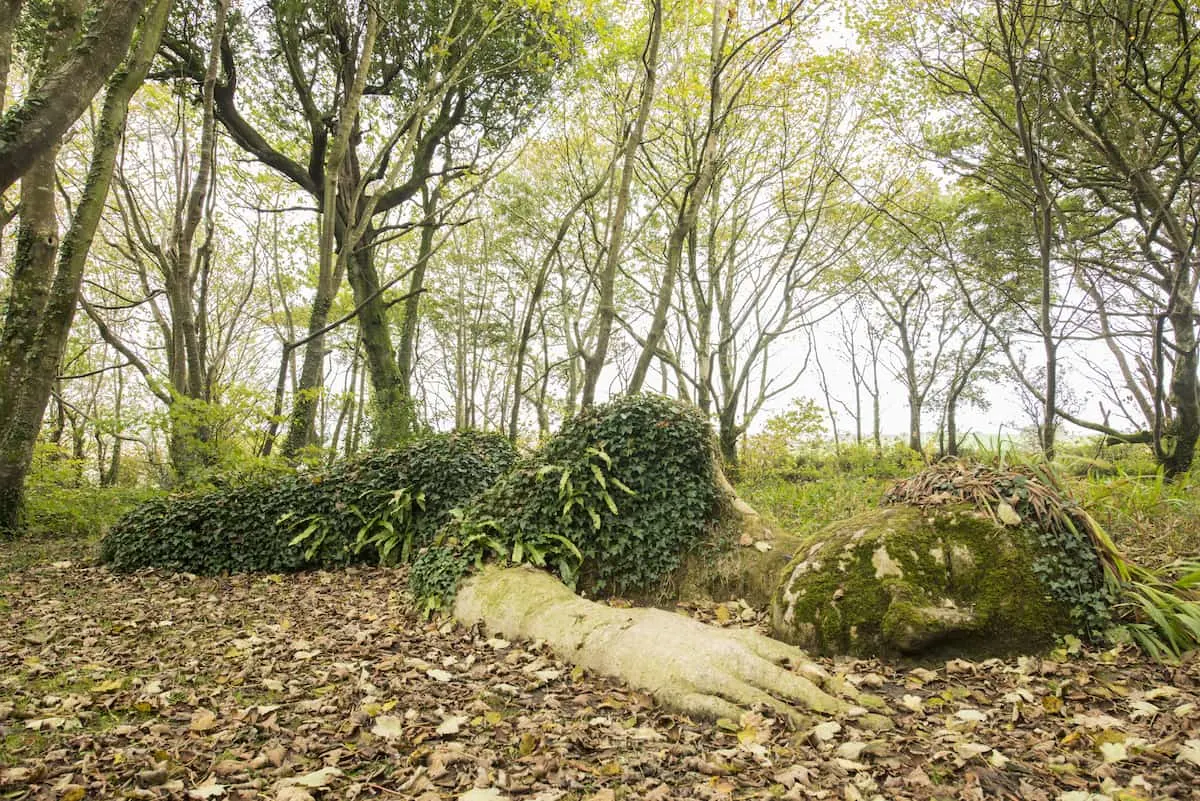
Wander through the real-life Secret Garden of Cornwall in The Lost Gardens of Heligan; where the actual story behind the gardens feels almost as mythical as the name suggests.
Heligan’s gardens were absolutely flourishing in the 19th century. The Tremayne family had developed the estate’s grounds into one of Cornwall’s premier outdoor spaces.
But the estate was abandoned during World War I, and the gardens spent half a century lost to time. The forgotten grounds soon fell into disrepair; eventually becoming derelict as the decades passed.
The gardens were neglected for so long that the entrance became completely overrun by plants and ivy. It was only the chance discovery of a hidden door in the 90s that led to the restoration of the gardens.
The ensuing recovery project was a huge success. Heligan is now home to one of the finest gardens in the UK. Its location within a valley creates a microclimate that allows a wide variety of plants to grow.
You can wobble across a Burmese rope bridge in The Jungle or go for a romantic stroll through The Sundial Garden: the Lost Gardens have an unmatched diversity, and are a real joy to explore.
Trebah Gardens
It would be a bit of a squeeze to fit in, but Trebah Gardens is en route to our next stop.
If you have the time, Trebah Gardens is worth a visit. The colourful gardens follow a gentle stream as it trickles down towards the seafront. The gardens are particularly vibrant in September when the hydrangeas come into bloom.
Kynance Cove
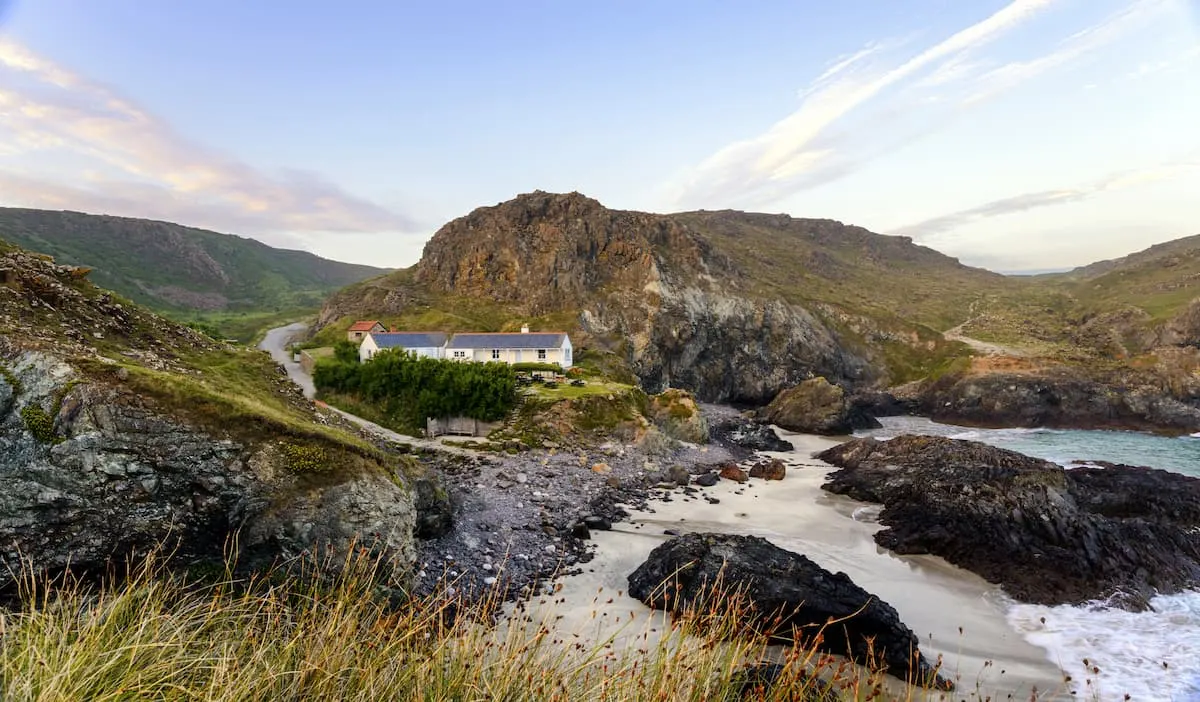
The Lizard Peninsula is one of the most dramatic – and photogenic – pieces of coastline in Cornwall.
Kynance Cove is the crown jewel of that already treasured peninsula. This is honestly quite the detour from the most direct route down the south coast – it will add just over an hour on to your travel time.
But it is worth it. Serpentine rock formations weave between the sand and sea in Kynance Cove. It is one of the most photographed locations in Cornwall, thanks to the sheltered cove’s unmistakable staggered headlands of rock, white sands and turquoise waters.
Climbing the hill opposite to Kynance Cove is possibly more impressive than being on the beach itself. It gives you a unique perspective on one of the most memorable vistas in Cornwall.
Kynance Cove is best seen at low tide, when the beach is fully visible.
Marazion
At the end of a long day, you just want to put your feet up and relax.
A road trip is exciting, but can be tiring. Marazion is a lovely place to unwind after hours of driving. The ancient market town is small, but pretty and charming. It’s perfect for an overnight stay.
If you’re looking for somewhere to eat, you will find a handful of cute pubs and cafes in the town. As you might have expected on the coast, they’re especially notable for their seafood offerings.
Marazion is a lovely town, but what really puts it on the map is its proximity to St. Michael’s Mount; the views of the castle island are incredible.
Day 2
After spending the early morning relaxing in Marazion, it’s time to get back to exploring.
St. Michael’s Mount
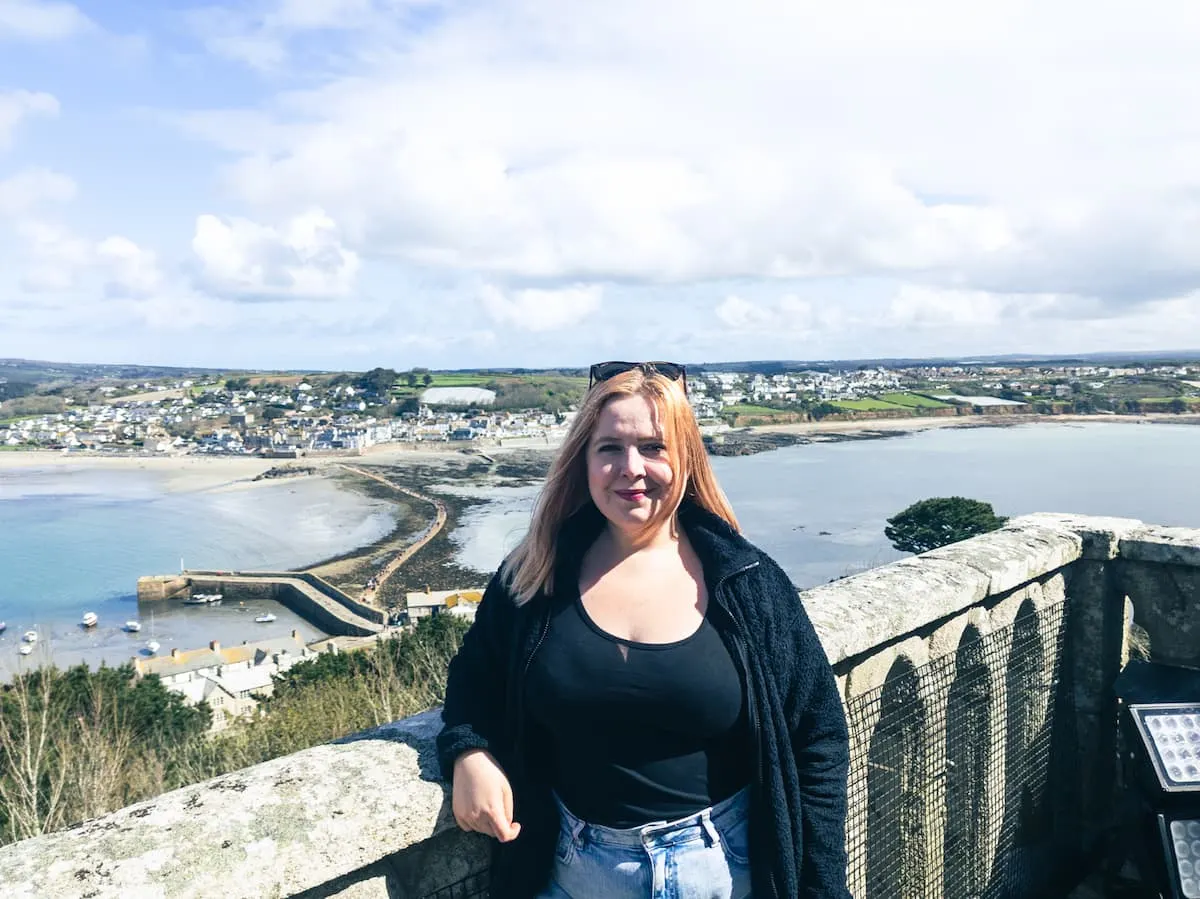
Cornwall’s answer to Mont Saint-Michel in France is located on the south coast in Mount’s Bay; it’s an island anchored to the mainland by the whims of the tide.
St. Michael’s Mount is as close to a fairy tale as you can experience in everyday life. The scene is breathtakingly romantic: a medieval castle is perched high above an island of lush greenery, cutting an unmissable outline against the open sky. Mount’s Bay is a sparkling turquoise colour, completing the image of almost unnatural beauty.
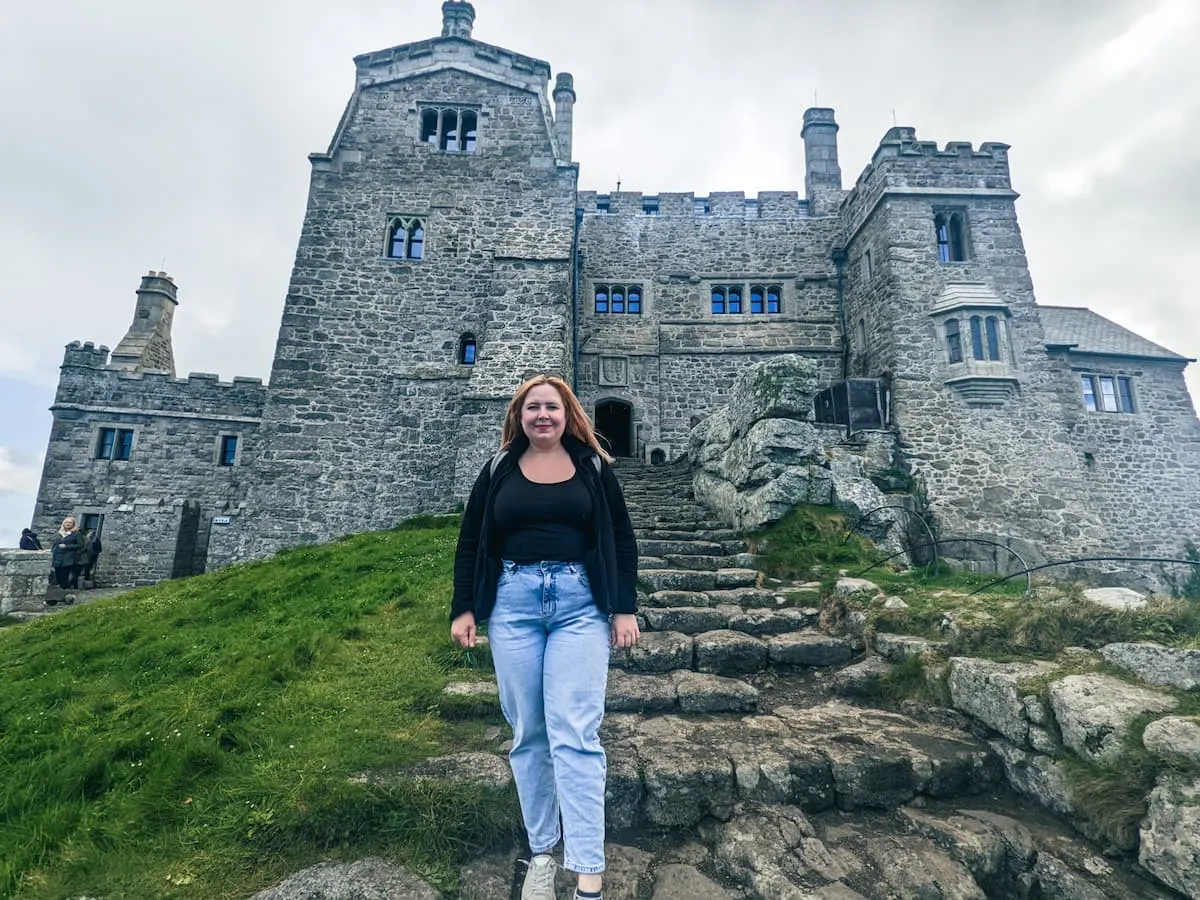
It’s so beautiful that it could easily be a purpose-built tourist attraction. But the castle has stood for centuries – the first priory on the island was built in 1135. It played a particularly active role in politics during the medieval period, when an imposter to the throne occupied the Mount.
You can explore the castle and gardens in the warmer months, but times are limited outside the peak of June, July and August.
St. Michael’s Mount is a tidal island: at high tide, it is cut off from the mainland. The water retreats to reveal a cobbled causeway winding across the bay, and you access the Mount by checking the tide times and embarking across this path. In April, ferries start to run between Marazion and the pretty harbour of St. Michael’s, allowing for extra visits during high tide.
Mousehole
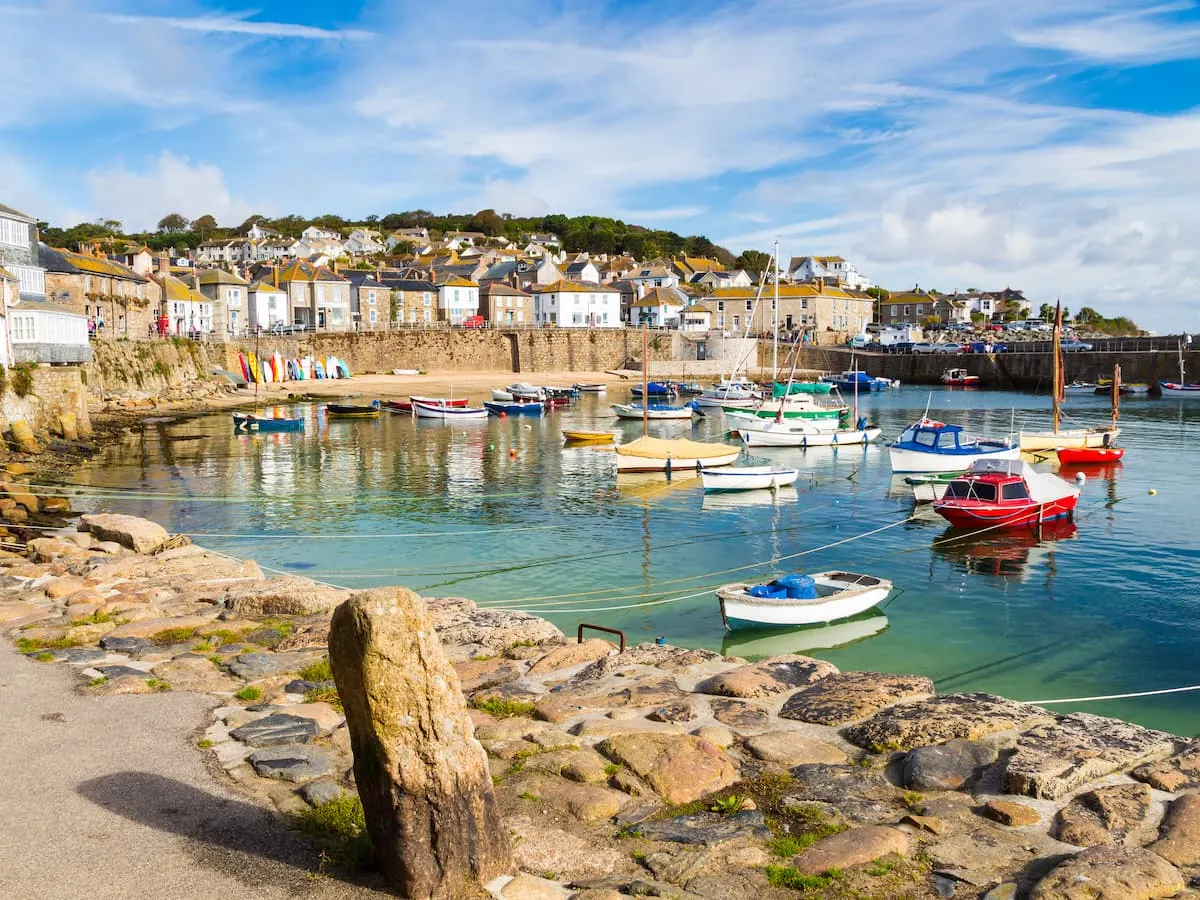
Skip across the bay from St. Michael’s Mount and you will land in Penzance; famously the setting of The Pirates of Penzance. But keep going – in truth, Penzance isn’t the loveliest town in Cornwall. Hidden just below it is the sweet village of Mousehole, once dubbed the “loveliest village in England” by poet Dylan Thomas.
Mousehole is a tranquil respite for any weary traveller. The tiny fishing village has an enchanting atmosphere, and despite its popularity, still feels authentically Cornish. You can indulge in a Cornish Cream Tea, visit a museum, or set off on a boat ride from the fishing port. For such a small place, there’s plenty to see and do.
Porthcurno
Winning the unofficial competition for most beautiful beach in Cornwall is no easy task, but Porthcurno somehow manages to stand a cut above the rest. This small slice of paradise is carved out of the cliffside, nestled in a narrow valley on Porthcurno Bay.
The water is a shade of blue more commonly seen in the Caribbean, and the beach is a golden layer of soft sand beneath your feet. The greenery of the cliffs on either side make for a striking burst of colour, and the contrast only enhances the beauty of Cornwall’s most breathtaking beach.
Allow yourself a few hours to lounge on the sands and swim in the sea if the weather is nice. Even if the skies are grey you can still enjoy a visit to Porthcurno. The circular walk up the hillside and across the coastline from Porthcurno to Penberth Cove is spectacular.
The unmissable sea views, picturesque Penberth harbour, and clifftop perspective over the beach make this a hike worth taking in all weathers. Wander slightly off track to reach Pedn Vounder beach – this is one of the finest views of a craggy cove in Cornwall, and is usually deserted.
Minack Theatre
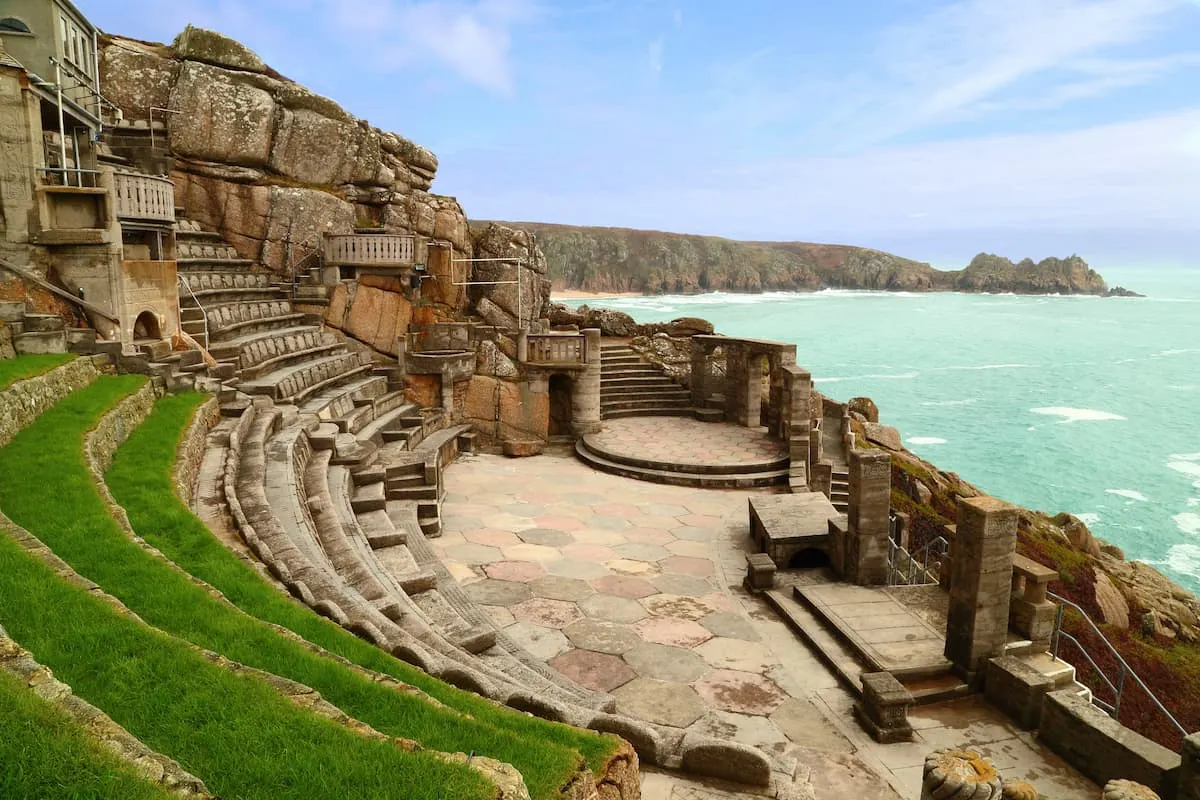
Even on a trip as brief as three days, you have to find the time to visit the Minack Theatre while in Cornwall. It is conveniently located on the cliffs overlooking Porthcurno beach – it’s so close that you don’t have to get back behind the wheel, you can just walk for five minutes and you’re there.
It’s hard to imagine a theatre in existence more picturesque than the Minack. Hanging on the edge of a cliff sloping down to the sea, the theatre looks impossibly romantic. It almost looks like it could be the recently unearthed discovery of ancient ruins; the Minack has all the appearance of a Roman amphitheatre.
In actuality, the Minack Theatre was built as a private playhouse. Dreamed up by Rowena Cade, the Minack’s first ever performance was fittingly Shakespeare’s stormy masterpiece, The Tempest.
During the summer season, when performances run from Easter to September, you could – and, maybe, should – catch a show. Matinee performances are fairly frequent and would fit into the schedule of a busy road trip itinerary. If there are no performances available, you can still tour the theatre.
The views over the sea from the theatre are simply sublime: no theatre has a better backdrop than the hazy blue of southern Cornwall’s sea and sky.
Mayon Cliff Shipwreck
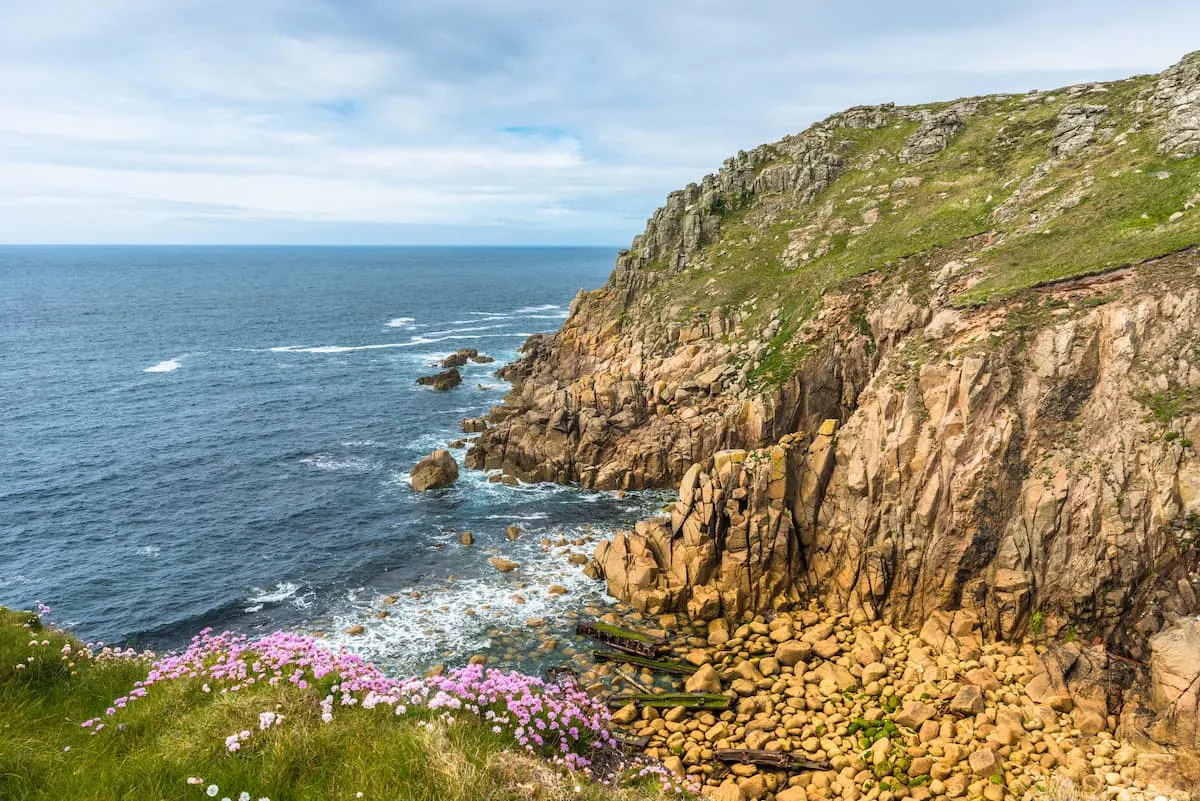
The Mayon Cliff Shipwreck is a slight detour from the usual tourist hotspots. Situated only a few miles from the wildly overrated Land’s End, the wreck of the RMS Mülheim has been stranded on the rocky inlet of Castle Zawn cove for almost twenty years.
The cargo ship has been teetering on the Cornish coast ever since its doomed voyage first ran into trouble. All that is left is the bow, which has been perched on the pebble beach since 2003, after a storm split the ship in two. You can walk to the wreckage as part of a scenic coastal route over Mayon Cliff.
Amble through a carpet of heathland on your journey along the perilous cliffs, enjoying sweeping vistas of the ocean and a glimpse of Bronze Age castle ruins, a Victorian lookout, and the distant Longships lighthouse.
Of course, once you arrive on the shipwreck beach there isn’t much to do but admire the atmospheric surroundings. It’s not a beach to lounge on, but you can spend some time looking out to sea trying to spot the wildlife. Dolphins and porpoises are common, but everything from basking sharks to killer whales have been spotted off this coastline.
Mên-an-Tol

From a 21st century wreckage to an ancient stone formation. Travel back 3500 years, long before even the founding of Ancient Rome, to Mên-an-Tol.
Cornwall has a surprising amount of these stone circles and formations; the ancient Cornish societies had an astonishingly advanced grasp of stonework and craftsmanship. But this is perhaps the most impressive of the many remnants of early civilisations in Cornwall. The unusual pierced circular rock is one of only two of its kind in the UK.
Cornwall is closer culturally to Wales, Scotland and Ireland, with its Celtic roots. There’s a distinct difference between Cornwall and the rest of England – it even has its own revived Cornish language. Visiting places like Mên-an-Tol gives us greater insight into a fascinating part of Cornwall’s history.
This will be the longest stretch of travelling on your second day, though none of the journeys are particularly strenuous – the drive from the Mayon Cliff Shipwreck to Mên-an-Tol takes around 30 minutes, and the following trek to St. Ives slightly less.
Visiting Mên-an-Tol won’t require too much of your time. It’s a quick stop, but one worthy of a packed itinerary.
St. Ives

End your second day in Cornwall in pretty St. Ives; a town famous for glorious beaches, a thriving art scene, and an idyllic harbour.
The appeal of St. Ives is no secret, so it does tend to get very busy in the summer. But even if you are road tripping in the middle of August, I think it’s a place you just can’t miss. St. Ives is a charming collection of winding streets and golden beaches. It has a lovely atmosphere; simultaneously bustling and relaxed.
You will find world-class art galleries in the town, with the Tate St. Ives a particular highlight. There’s great food options as well, with plenty of variety. The Cornish Deli does a mean pasty.
Cobbled streets, quaint cottages and alabaster townhouses make up the town centre; the Down-a-long is especially charming. St Ives is a fantastic blend of culture and beauty – I can’t think of anywhere better to end your second day in Cornwall.
Day 3
Begin the final day of your road trip through Cornwall with breakfast by the beach in St. Ives. If you’re particularly fearless, go for a bracing early morning swim – you only have a few dozen beaches to choose from.
Perranporth
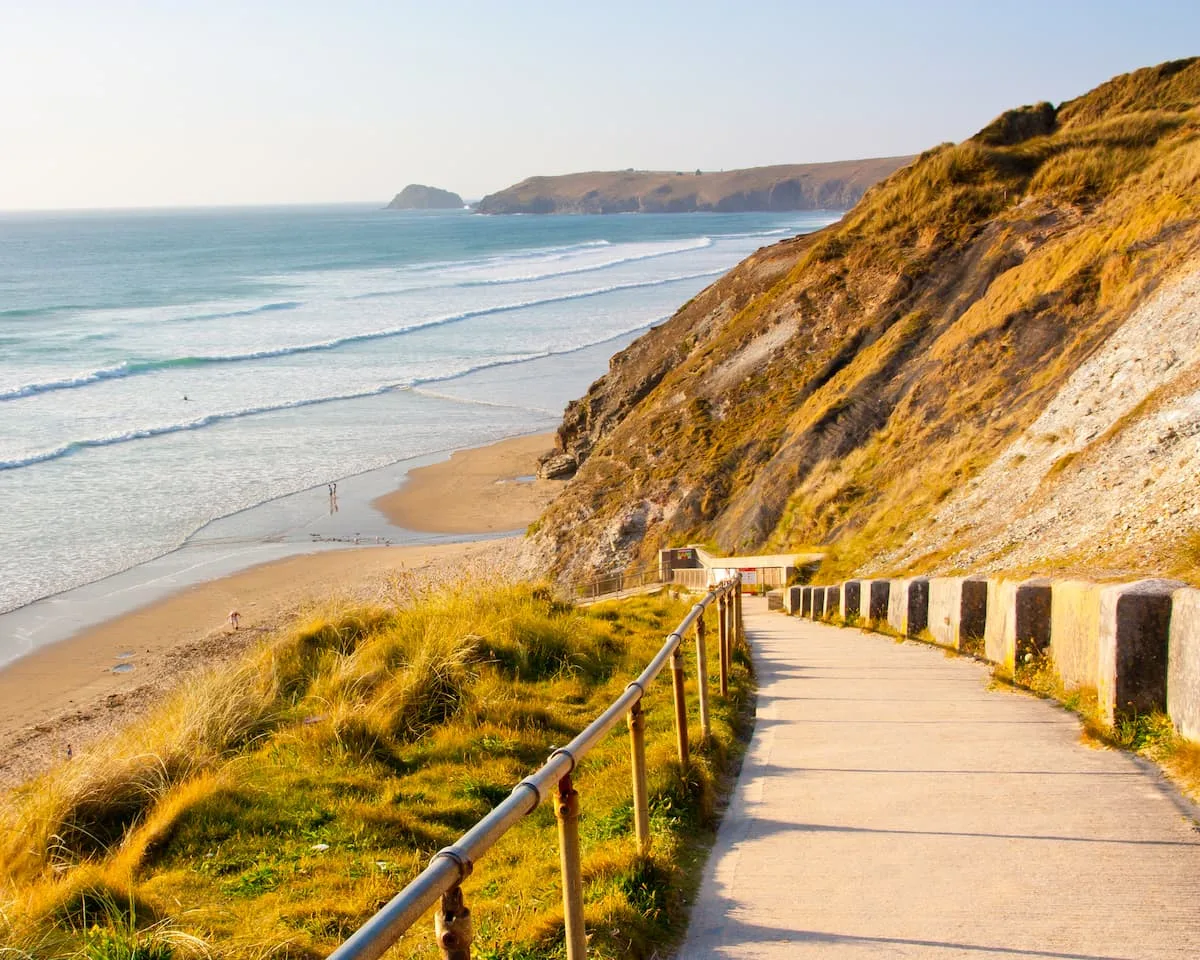
Explore the St. Agnes Heritage Coast by visiting the longest stretch of uninterrupted sand in Cornwall at Perranporth.
It’s a lovely way to while away a few hours. After all, no trip to Cornwall is complete without thoroughly perusing its beaches.
If you’re all beached out or the weather isn’t so great, feel free to skip this part of the road trip. But Perranporth is one of the finest beaches on the north coast; it’s well worth a few hours of your time if you’re willing.
Polzeath to the Rumps
The Cornish coast is made for windswept hikes. The jagged cliff edges, golden beaches and endless ocean views are all meant to be savoured.
You can enjoy a scenic walk on the northern coast as you wind your way back up through Cornwall. Polzeath is a sweet little village, but not all that notable by itself. The nearby scenery, which includes an Iron Age hillfort, is what makes this a worthwhile trip.
Granite cliffs and the twin headlands of ‘the Rumps’ sit alongside the clear blue waters of the Atlantic Ocean. This is an excellent walk with very little foot traffic; you feel almost completely alone on these rugged hills. It also gives you a chance to get out of the car and stretch your legs, seeing some of Cornwall’s most beautiful countryside while you do so.
Port Issac
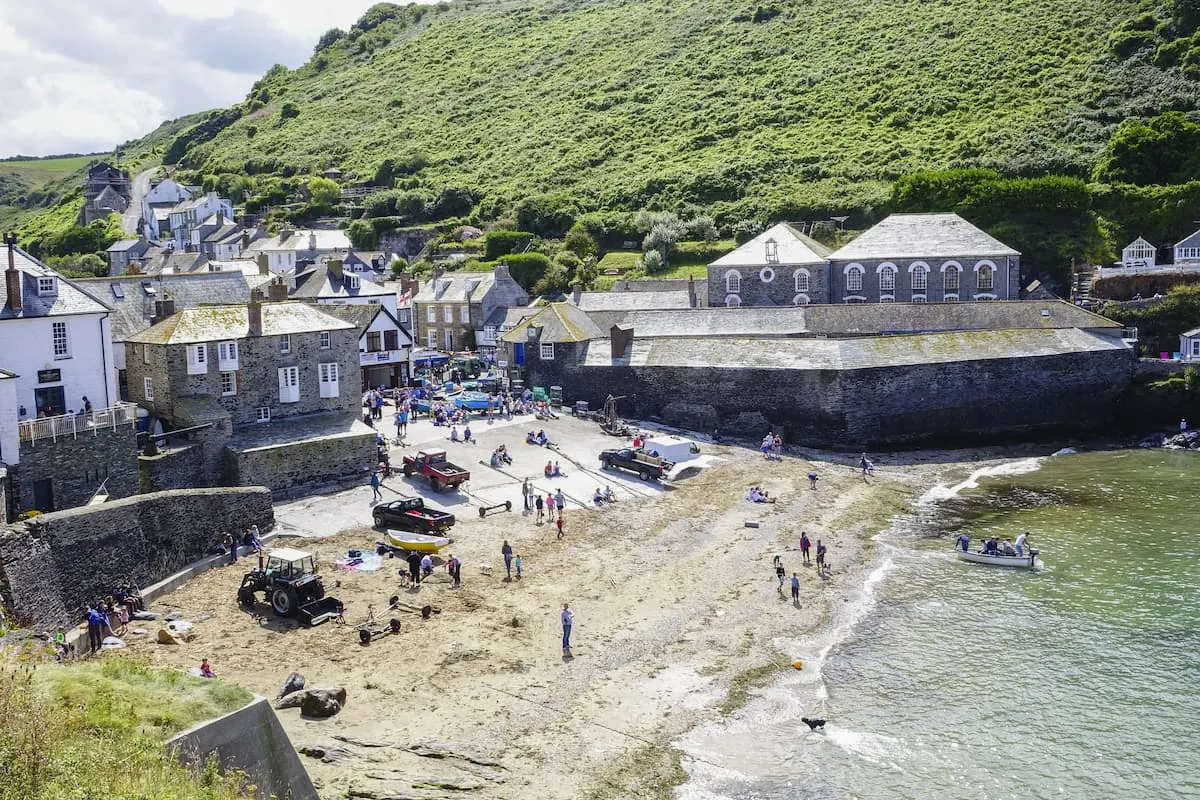
Pretty fishing villages are a dime a dozen in Cornwall. But there are some that continue to charm even repeat visitors with their beauty. Port Issac is one of them.
The pretty fishing village is backed by green hills and opens on to the sea with a little beach. Port Issac is ideal for a lunch stop – it would give you enough time to explore the scenic village and relax in a cute cafe. The Cornish are incredibly loud advocates of a cream tea, and Angelique’s Tea Room does one of the best.
Tintagel Castle
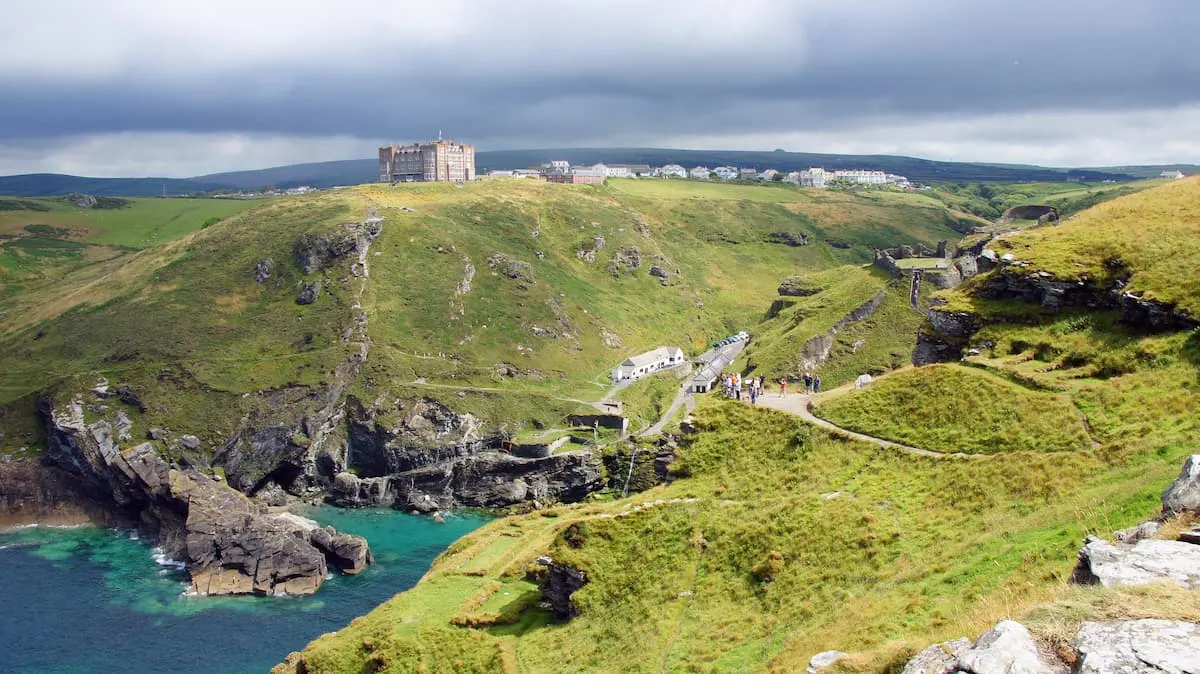
Enter into a land of myth and legend at Tintagel Castle, and immerse yourself in the story of King Arthur and his Roundtable.
There’s an air of mystery – and, some would say, magic – around Tintagel that has inspired storytellers for centuries. The setting is so dramatic that people tend to assume it simply must have had a grander purpose. According to legend, Tintagel is the birthplace of King Arthur.
Though the medieval castle is little more than ruins, it is easy to get swept up in the mythos of it all. It’s incredibly atmospheric, and the scenery is stunning. The precarious walk down to Merlin’s Cave, where the illustrious wizard supposedly lived, is especially memorable.
Boscastle
The final stop on our whirlwind tour of Cornwall is a village with huge character. It’s exceedingly pretty, as most Cornish villages are, but has an eccentricity that is unique to Boscastle. This is a village with a strong sense of personality, and oodles of charm.
Famously the victim of flash flooding in 2004, Boscastle has recovered in spades in the years since. Stroll alongside the river as it meanders down through the tiny port village – the stone cottages of the village are built on either side of the river within a deep valley.
It’s an exceptionally beautiful setting. The location is matched in charm by the inhabitants. Boscastle is a friendly village with some unusual quirks – you can even visit a Museum of Witchcraft and Magic, and see an eclectic mix of voodoo dolls and crystal balls in the collection.
Road Trip Roundup
By the end of the three days, you will have packed in as much of Cornwall as is physically possible. You will have seen the rainforest of the Eden Project, the romantic St. Michael’s Mount, half a dozen gorgeous beaches, and a handful of charming towns and villages.
Your road trip will have ticked off the best of the Cornish coast.
But this little taster of Cornwall is a great introduction to the region, and is sure to leave you eager to return for more!

Kat
Hi, I'm Kat, an Australian that moved to London in 2013 to start a new adventure. What a roller-coaster that was! I love helping others move to the UK and people explore the world! I’d be honoured if you’d say, “Thanks!” with a £3 coffee on Ko-fi.

